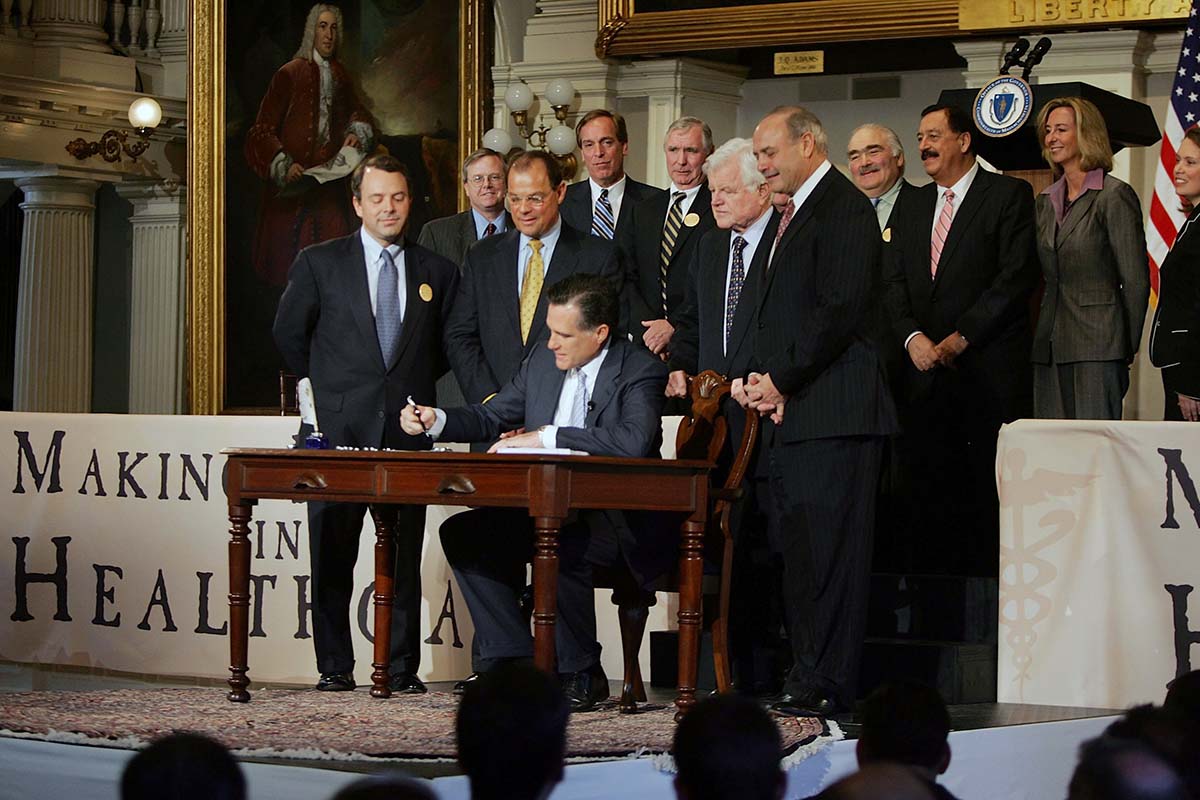The congressional GOP should allow states to emulate Romneycare, by structuring ACA funds as block grants to reward states for increasing overall insurance coverage by targeting public funds to fill gaps in private insurance.
Over the past year, the Republican Congress failed to enact an attractive alternative to the Affordable Care Act, with the Congressional Budget Office estimating its various proposals as leaving between 17 and 23 million more individuals uninsured. Yet, the healthcare reform signed into law by Mitt Romney as governor of Massachusetts covered more people than under the ACA, despite spending less in public funds.
According to the U.S. Census Bureau, the proportion of the Massachusetts population that was uninsured actually rose from 3.6 percent in 2013 to 4.4 percent in 2014, when Obamacare replaced Romneycare – even though the state’s economy was growing robustly and the ACA expanded the share of the state’s population enrolled in Medicaid jumped from 19.4 percent to 23.6 percent.
How did Romneycare manage to outperform Obamacare? By better-targeting its assistance at gaps in coverage, and by being more careful to ensure that increased public healthcare spending served to supplement private spending rather than to supplant it.
The United States is often thought to have a small government approach to healthcare policy, but U.S. public spending on healthcare (8.3 percent of GDP in 2014) in fact exceeds that in Canada (7.4 percent) and the United Kingdom (7.0 percent). The main difference between the countries is that U.S. public healthcare entitlements have traditionally been reserved for those unable to purchase their own insurance (the disabled, the elderly, and certain needy low-income groups), while a similar amount of funding in Britain and Canada has mostly been used to pick up costs that the middle-class would have been capable of bearing by themselves. The result is that private funding increases the total value of healthcare consumed in the U.S. by a further 8.9 percent of GDP, but only by 3.0 percent in Canada and 1.4 percent in Britain.
Although the ACA rightly sought to fill gaps in coverage suffered by low-income individuals and those with pre-existing conditions, its expansion of public entitlements has also displaced privately-financed coverage. The ACA’s regulations have caused unsubsidized insurance premiums to soar, encouraged subsidy-eligible individuals to abandon private coverage for Medicaid and the exchange, and flipped work incentives so that able-bodied adults can often get more generous healthcare benefits by staying out of work than by accepting a job.
As a recent Manhattan Institute Issue Brief demonstrates, around 40 percent of the ACA’s spending went to individuals who already had private insurance coverage. From 2007 to 2017 (similar stages of the business cycle, with unemployment at 4.5 percent), the share of the population aged under 65 in publicly subsidized insurance rose from 15 percent to 31 percent, while the share uninsured declined from 17 percent only to 10 percent — with the proportion on unsubsidized plans falling from 68 percent to 59 percent. While this was in part the result of the provision of subsidies to low-income individuals enrolled in the individual market, it was also the product of the poorly-targeted Medicaid expansion – which, according to a range of econometric studies, served to displace private insurance in 20 percent to 30 percent of cases.
Romneycare managed to insure a larger proportion of the population because it was careful to target its subsidies at the few who truly needed them to get insurance, rather than allowing it to spread to others who already had it. Eligibility of able-bodied childless adults for Medicaid was limited to the long-term unemployed and subject to enrollment caps; while exchange subsidies were more generous than those under the ACA but with a lower income cut-off (concentrating help on a group more likely to be uninsured). At the same time, it imposed fewer requirements to inflate the cost of unsubsidized insurance, and did more to prevent those with an offer of employer-sponsored insurance from enrolling in publicly-subsidized plans.
The congressional GOP should allow states to emulate Romneycare, by structuring ACA funds as block grants to reward states for increasing overall insurance coverage by targeting public funds to fill gaps in private insurance. States should be encouraged to design their Medicaid eligibility rules so that the unemployed are not permanently entitled to more generous healthcare benefits than most workers are able to get from their employers. States should also be encouraged to focus exchange subsidies on low-income individuals or those with pre-existing conditions – allowing those able to afford unsubsidized insurance to purchase recently-deregulated plans from fully-competitive markets off the exchange.
The ACA filled in gaps in insurance coverage, but it did as much to displace well-functioning private insurance, and has consequently left many still uninsured. Romneycare showed that it is possible to cover more people than under Obamacare by better-targeting ACA funds at those who are in the greatest need of assistance. By reforming the ACA, to enable and encourage other states to do the same, the GOP can improve America’s health insurance coverage – and give their own political prospects a boost too.
This piece originally appeared at the Washington Examiner
_____________________
Chris Pope is a senior fellow at the Manhattan Institute. Follow him on Twitter here.
This piece originally appeared in Washington Examiner
